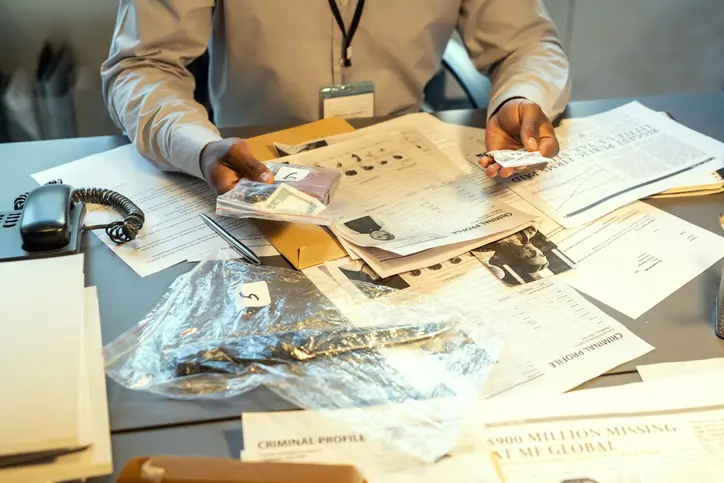
Image source: Unsplash
Narcotics investigations play an integral role in dismantling the financial and operational foundations of organized crime. These investigations go beyond arresting street-level dealers; they aim to expose and disrupt entire networks that profit from drug trafficking. By tracing financial transactions, intercepting communication, and using undercover operations, law enforcement agencies can pinpoint key players and their methods.
According to Chief Miguel Iglesias, organized crime groups often rely on drug profits to fund a range of illicit activities, making narcotics enforcement a powerful tool against broader criminal enterprises. Through strategic collaborations, modern technology, and persistent investigation, authorities can weaken these networks and reduce their influence in communities.
Narcotics Investigations
Narcotics investigations focus on uncovering and stopping the production, distribution, and sale of illegal drugs. These efforts are carried out by a range of agencies, including local police departments, state task forces, and federal organizations like the DEA. Investigations often start with anonymous tips or routine traffic stops that reveal larger criminal operations hidden beneath the surface.
The main objective is to identify key players within drug operations, such as suppliers and traffickers, while mapping out how drugs move through different regions. In some cases, investigations begin with street-level arrests that lead to broader networks. Patterns in drug-related crimes, such as overdose spikes or increased gang activity, often guide where and how these investigations begin.
Coordination between different law enforcement bodies is paramount, especially when drug operations extend across state lines or involve international sources. By sharing intelligence and pooling resources, agencies are better equipped to disrupt complex drug networks. Successful coordination can mean the difference between dismantling a local ring and stopping an international syndicate.
Connection Between Drug Trafficking and Organized Crime
Drug trafficking plays a central role in funding large-scale criminal organizations. These groups rely on the revenue from narcotics to finance a wide range of illicit activities, including arms dealing, human trafficking, and bribery. The drug trade provides a steady and lucrative income stream, allowing these networks to expand their influence and operations. In many regions, this illicit economy rivals legitimate industries in size and power.
In cities plagued by organized crime, drug profits are often laundered through seemingly legitimate businesses, making it difficult to trace the money back to its criminal roots. Cartels and syndicates use this capital to purchase weapons, pay off corrupt officials, and enforce control through violence. As drug markets grow, so does the power and reach of the organizations behind them. These often result in local communities becoming entangled in cycles of violence and fear.
Common Strategies in Drug Investigations
Investigators use a combination of surveillance, undercover work, and digital monitoring to gather information on drug operations. Plainclothes officers may infiltrate networks by posing as buyers or low-level dealers, while electronic surveillance tracks communication between suspects. These methods help piece together how drugs are sourced, distributed, and sold. Long hours and meticulous planning often go into building each case.
Wiretaps, GPS tracking, and confidential informants often play a vital role in uncovering the inner workings of drug rings. In many cases, one arrest can lead to a chain reaction of leads, exposing multiple layers of the organization. This requires careful coordination to ensure evidence is legally obtained and admissible in court. Investigators must also adapt to encryption and burner phones commonly used by traffickers.
Interagency cooperation is also a key component. When local, state, and federal units share intelligence and collaborate on operations, the chances of intercepting large shipments or dismantling major players increase significantly. Such joint efforts have led to the takedown of entire trafficking corridors spanning across multiple jurisdictions. These partnerships often involve months of planning and intelligence sharing.
Building a Case Against Criminal Networks
Successful prosecutions depend on gathering a wide range of evidence that connects individuals to specific roles within a criminal network. This includes surveillance footage, phone records, financial documents, and testimony from informants who may have firsthand knowledge of the organization’s structure and operations. Prosecutors aim to show not just isolated drug offenses but a pattern of coordinated activity. It’s about proving conspiracy and intent, not just possession or sale.
Rather than focusing solely on street-level dealers, investigators often work to trace the chain of command upward. Identifying who gives the orders, who handles the money, and who oversees logistics can reveal the organization's full scope. This helps ensure that those with the most influence face appropriate legal consequences, not just the individuals at the bottom of the hierarchy.
Impact of Investigations on Organized Crime
Large-scale narcotics investigations have led to the collapse of long-standing criminal networks. When law enforcement succeeds in removing key individuals, such as financial coordinators, enforcers, or top suppliers, it sends shockwaves through the structure of these organizations. Operations that once seemed untouchable begin to unravel from within.
The impact goes above arrests. Disrupting drug supply chains often leads to a noticeable drop in local violence and addiction-related emergencies. Neighborhoods long affected by drug activity sometimes experience a renewed sense of safety and stability after successful investigations. The ripple effect can lead to social and economic improvements in vulnerable communities. Public trust in law enforcement also grows when visible results are achieved.
Ongoing Challenges and the Path Forward
Criminal networks constantly evolve, adopting new technologies and shifting tactics to avoid detection. Encrypted communications, cryptocurrency transactions, and the dark web present modern challenges that require equally advanced investigative tools. Investigators must stay ahead through training, technological upgrades, and adapting to the changing digital landscape.
International cooperation is becoming more critical, especially when trafficking routes span across continents. Legal differences between countries can complicate extradition and evidence sharing, slowing down progress. Despite these hurdles, ongoing innovation in forensic science, data analysis, and cross-border partnerships continues to strengthen the fight against organized drug crime.


